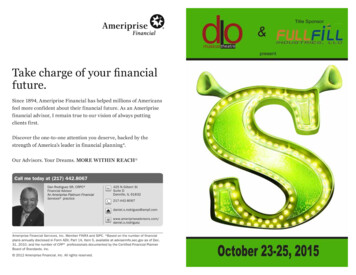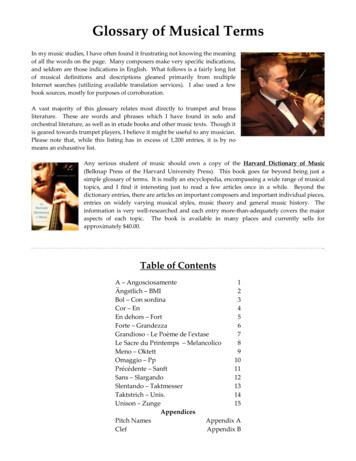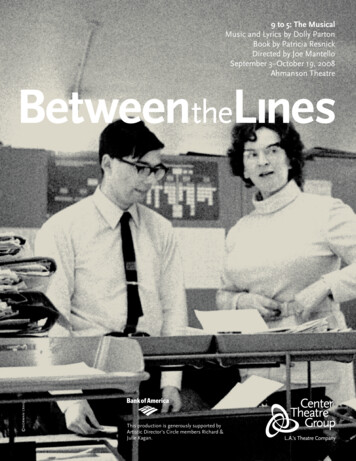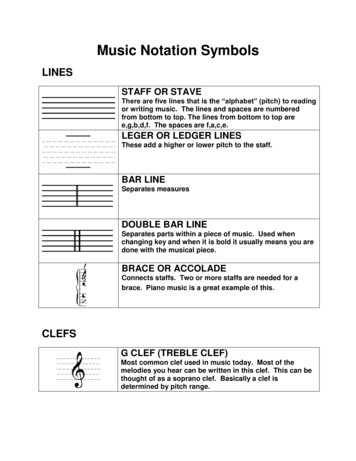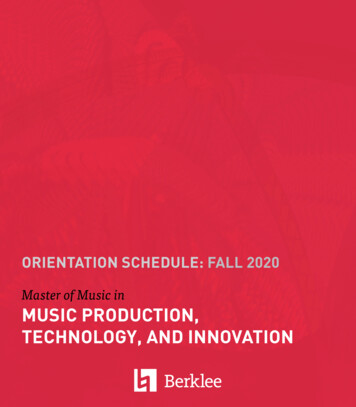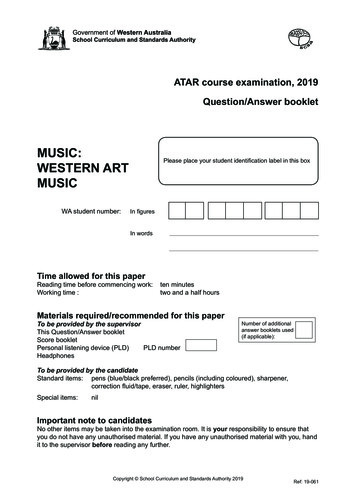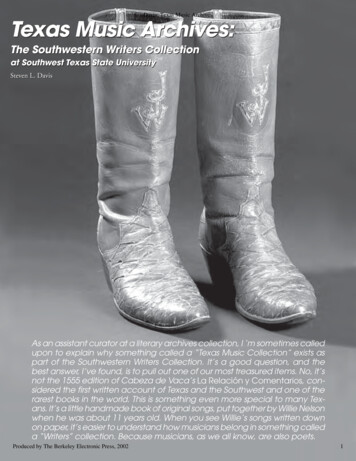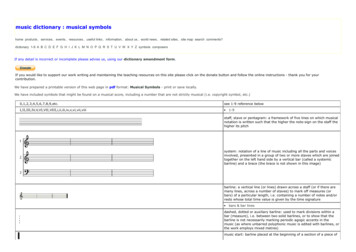
Transcription
music dictionary : musical symbolshome products. services. events. resources. useful links. information. about us. world news. related sites. site map search comments?dictionary 1-9 A B C D E F G H I J K L M N O P Q R S T U V W X Y Z symbols composersIf any detail is incorrect or incomplete please advise us, using our dictionary amendment form.If you would like to support our work writing and maintaining the teaching resources on this site please click on the donate button and follow the online instructions - thank you for yourcontribution.We have prepared a printable version of this web page in pdf format: Musical Symbols - print or save locally.We have included symbols that might be found on a musical score, including a number that are not strictly musical (i.e. copyright symbol, VIII,i,ii,iii,iv,v,vi,vii,viiisee 1-9 reference below1-9staff, stave or pentagram: a framework of five lines on which musicalnotation is written such that the higher the note-sign on the staff thehigher its pitchsystem: notation of a line of music including all the parts and voicesinvolved, presented in a group of two or more staves which are joinedtogether on the left hand side by a vertical bar (called a systemicbarline) and a brace (the brace is not shown in this image)barline: a vertical line (or lines) drawn across a staff (or if there aremany lines, across a number of staves) to mark off measures (orbars) of a particular length, i.e. containing a number of notes and/orrests whose total time value is given by the time signaturebars & bar linesdashed, dotted or auxiliary barline: used to mark divisions within abar (measure), i.e. between two solid barlines, or to show that thebarline is not necessarily marking periodic agogic accents in themusic (as where unbarred polyphonic music is edited with barlines, orthe work employs mixed metres)music start: barline placed at the beginning of a section of a piece of
musicmusic end: barline denoting the end of a piece of musicbrace: used with a line to joining multiple staves, for example, asfound in piano musicbracket: used with a perpendicular line joining multiple staves, forexample, as found in piano musicclef: graphical symbol placed on the left of the stave whichestablishes the relationship between particular note names and theirposition on the staff lines and spaces (i.e. tells us which pitch "class"that stave belongs to).treble (G2) G-clefbass (F4) F-clefalto (C3) C-clefsoprano (C1) and mezzosoprano (C2) C-cleftenor (C4) C-clefbaritone (C5) C-clef, baritone (F3) F-clef and subbass (F5) F-clefFrench violin or French (G1) G-clefpercussion or indefinite pitch clef - not shownAt the suggestion of Nick Meiners, we show the relative pitchpositions of the commonly used clefsG-clef (e.g. treble clef) marks G above middle CC-clef (e.g. alto clef) marks middle CF-clef (e.g. bass clef) marks F below middle Cold C-clef sign, i.e. old alto, tenor, soprano, baritone andmezzosoprano clef signa G-clef sign found in the score of La Bohème by Giacomo Puccini(1858-1924) published by Ricordi: a G-clef used for the tenor voice(for this reason it is called the tenor G clef), where the note soundsone octave lower than written had the clef been the standard treble Gclef[image provided by John Garside]a C-clef sign found in the score of Sankey and Stebbins - The MaleChorus, 'for use in Gospel Meetings, Christian Associations and other
Religious Services' which marks middle C as being on the secondspace from the top of four. The clef is equivalent to an octave G clefcalled the tenor G clef where that space would be occupied by a Cone octave above middle C but the note sounds one octave lower[image provided by Dick Adams]G-clef ottava altaoctave clefsG-clef ottava bassaoctave clefsF-clef ottava altaoctave clefsF-clef ottava bassaoctave clefsalternative percussion clef, indefinite pitch clef or neutral clefpercussion or indefinite pitch clefthe main elements of a musical scorecommon time: equivalent to a time signature of 4/4, namely fourcrotchets (quarter notes) to a bar (measure)common time, alla breve/cut time, alla cappella timealla breve: also called 'cut time' or 'alla cappella time'; marked with alarge C with a vertical line through it, used for quick duple time inwhich the minim or half note is given one beat instead of two.(occasionally written with two parallel vertical lines through a large C)
common time and alla breve/cut timeanatomy of a note, a single sound of a particular pitch and lengthwhich is notated with a symbol made up of a notehead (in all cases),a stem (in some cases) and a flag (in some cases), and which withnotes bearing flags are grouped together using a beamin music for stringed instrument, a single pitch to be played on twodifferent strings, each appropriately fingered. A similar notation mightalso be found in a short score where two parts are being notated on asingle line as a unison, in which case the upward stem will be of thehigher or first part and the downward stem will be of the lower orsecond part.sprechgesang stemsprechgesang: speech-song, a term used by Arnold Schönberg(1874-1951) to describe a voice delivery midway between song andspeech, although he preferred the terms sprechstimme speakingvoice (which was used by Humperdinck in Königskinder [1910]),sprechmelodic (speech melody) or rezitation (recitation)Note Signnumber equalto1 semibreveEnglishbreve/2 (meaning bleredondaquadrada (f.)orbreu (f.)ganze Takt(note)redondaorsemibreverodona (f.)1semibrevewhole notesemibrevesemi-brèveorronde(meaning round)2minimhalf noteminimaorbiancablanche(meaning white)Halbe(note)orhalbe Takt(note)blancaormínimablanca (f.)4crotchetquarter notesemiminimaorneranoire(meaning black)Viertel(note)negranegra (f.)8quavereighth notecromacroche(meaning hook)Achtel(note)corcheaorcromacorxera (f.)semiquaversixteenth notesemicromadouble crocheSechzehntel(note)semicorchea semicorxera16
(meaning double hook)32demisemiquaverthirty-second notebiscromatriple croche(meaning triple hook)Zweiunddreissigstel(note)fusafusa (f.)64hemidemisemiquaversixty-fourth notesemibiscromaquadruple croche(meaning fusa ntuple crochegarrapateaHundertundachtundzwanzigstel(note) orcuartifusasemihemidemisemiquaverone hundred and twenty-eighth128 ornotequasihemidemisemiquaverRestnumber equal to 1semibreve1/21or(f.)Englishbreve restsemibreve restAmericandouble-wholerestwhole restItalianpausa di brevepausa disemibreveFrenchbâtonorpause de brèveorsilence de brèvepauseGermanSpanishCatalandoppel Pausesilencio decuadradaorpausa decuadradaorsilencio debreveorpausa debrevedoble pausa (f.)orpausa dequadrada (f.)ganze Pausesilencio deredondaorpausa deredondaorsilencio desemibreveorpausa desemibrevepausa (f.)orpausa de rodona(f.)media pausaorsilencio deblancaorpausa deblancamitja pausa (f.)orpausa de blanca(f.)silencio denegraorpausa denegraquart de pausa(m.)orpausa de negra(f.)2minim resthalf restpausa di minimademi-pausehalbe Pause4crotchet restquarter restpausa disemiminimasoupirViertelpause
orsilencio desemiminimaorpausa desemiminima8163264128quaver restsemiquaver restdemisemiquaver resteighth restpausa di cromasixteenth restpausa disemicromathirty-second restpausa di biscromademi-soupirquart de soupirhuitième de soupirAchtelpausesilencio decorcheaorpausa decorcheavuitè de pausa(m.)orpausa de corxera(f.)Sechzehntelpausesilencio desemicorcheaorpausa desemicorcheasetzè de pausa(m.)orpausa desemicorxera (f.)Zweiunddreißigstelpausesilencio defusaorpausa defusatrenta-dosè depausa (m.)orpausa de fusa (f.)silencio desemifusaorpausa desemifusaseixanta-quatrède pausa (m.)orpausa desemifusa (f.)hemidemisemiquaver rest sixty-fourth restpausa disemibiscromaseizième de r one hundred and twentyresteighth restpausa dicentoventottavocent-vingt-huitièmede soupirsilencio degarrapateaHundertundachtundzwanzigstelpause orpausa degarrapateamulti-rest or multiple measure rest: where a number of bars containonly rests, in instrumental parts (and sometimes in scores), the barsare 'collected' together and shown as a single bar contain a resttogether with the number of consecutive bars given by a largenumber placed centrally above the staff over the single barvarious note heads listed left to right:top row: plus, circle x, square white, square black, triangle up white,triangle up black, triangle left up white, triangle left up black, triangleright up whitemiddle row: triangle right up black, triangle down white, triangledown black, triangle right down white, triangle right down black,moon white, moon black, triangle-round down white, triangle-rounddown blackbottom row: parenthesis, white, black, cluster white, cluster black,croix, xcertain note heads have specific meaning, for example:diamond: special playing modes or notes such as: half-valve,tablature for string harmonics, falsetto voice, silent depression ofkeys, held keysX: indeterminate pitches, spoken voice and unvoiced sounds, release
of certain held notes, noises, .round pierced by stems: sounds of air blown through aninstrumentvertical arrow: highest or lowest pitches possible on an instrumenttriangular : for trianglesas a notehead: indeterminate pitches, spoken voice and unvoicedsounds, release of certain held notes, noises, .Xin jazz notation for wind instruments or string instruments, a 'ghostnote' is indicated by using an 'x' for the notehead rather than theusual oval. A ghost note is one that is to be played less strongly thanthe notes around it, the effect is also called 'anti-accent'hauptstimme, (German) principal part or voicenebenstimme, (German) subsiduary or secondary voice or lineottava alta, play notes under this sign one octave higher than writtenif used with the treble clef, or an octave lower than written if usedwith the bass clef [entry amended by Steven Sherrill]ottava bassa, play notes under this sign one octave lower thanwritten (used more commonly in the notation of popular music andjazz)[entry corrected by Charles Whitman]quindicesima alta, play notes under this sign two octaves higher thanwritten if used with the treble clef, on two octaves lower than writtenif used with the bass clef[entry suggested by Charles Whitman]quindicesima bassa, play notes under this sign two octaves lowerthan written (used more commonly in the notation of popular musicand jazz)[entry suggested by Charles Whitman]the barline that marks the beginning of a passage that is to berepeated, also called 'open repeat', 'begin-repeat' or 'repeat start'the barline that marks the end of a passage that is to be repeated,also called 'close repeat', 'end-repeat' or 'repeat end'repeat: the 'repetition' signs indicates that a section of a piece ofmusic is to be played a second time - where this is the first section ofthe piece the left hand sign may be absent - however, where therepeat is of a later section, the left and right hand signs mark theextent of the sectionrepeated sectionsan example of volta brackets, also called 'first ending' and 'secondending': in this case, a section performed only the first time it isreached otherwise the performer plays a later section usually marked
in a similar way but with a 2. and with no vertical line at the end ofthe sectiontremolo: one of a number of abbreviations used in musical notation,in this case for repeated notes, which can be marked as individuals ormarked as chords(note the angled line or lines, also called slashes, passing through thenote stems)sometimes a horizontal array of dots may be placed over the note(instead or or additional to the slashes confirming the number ofnotes to be played through the duration of each 'slashed' note)Note: in drum or timpani parts, notes with their stems crosseddiagonally by two or, more commonly three, lines usually indicate arolltremolo or alternations: repeated sequence of two notes a particularinterval apart(note the angled line or lines lying between pairs of notes)do not confuse with the caesura the lines of which pass through thetop line of the staff and are steeperNote: where the two principal notes have stems, and there is nolikelihood of confusion, the beams may actually connect to them: seebar 2, bass staff, in the example belowsimile marks, used to show repeated groups or bars (see immediatelybelow for more information)repeated passage using simile marksdo not confuse with the caesura the lines of which pass through thetop line of the staff
repeated bars using simile marksD.C.(Italian: from the beginning) an abbreviation of da capo, indicatingthat the player should start from or go back to the beginning of thepiece of musicthe sign or segno (Italian: sign)D.S.(Italian: from the sign) an abbreviation of dal segno, term indicatinga place from which a section of a piece is to be played, that placemarked with a segnodal segno, D.S. (abbrev.): (Italian) from the signda capoD.C. al Fine(Italian: from the beginning to the end) an abbreviation of da capo alfine, indicating that the player should go back to the beginning andthen end at the fine markFine(Italian: the end) a term placed where a piece or a section of a pieceof music is to endused with an instruction such as al Coda or 'to coda', this sign marksthe beginning of coda itself: a circle or oval with a cross inside it(corrected by Kim Krenzer)fermata (It.), Fermate (Ger.): a musical symbol placed over a note orrest to be extended beyond its normal duration, and occasionallyprinted above rests or barlines, indicating a pause of indefiniteduration. The word lunga (Shortened form of the Italian lunga pausa,meaning "long pause") is sometimes added above a fermata toindicate a longer duration. Some modern comp
music dictionary : musical symbols If any detail is incorrect or incomplete please advise us, using our dictionary amendment form. If you would like to support our work writing and maintaining the teaching resources on this site please click on the donate button and follow the online instructions -
